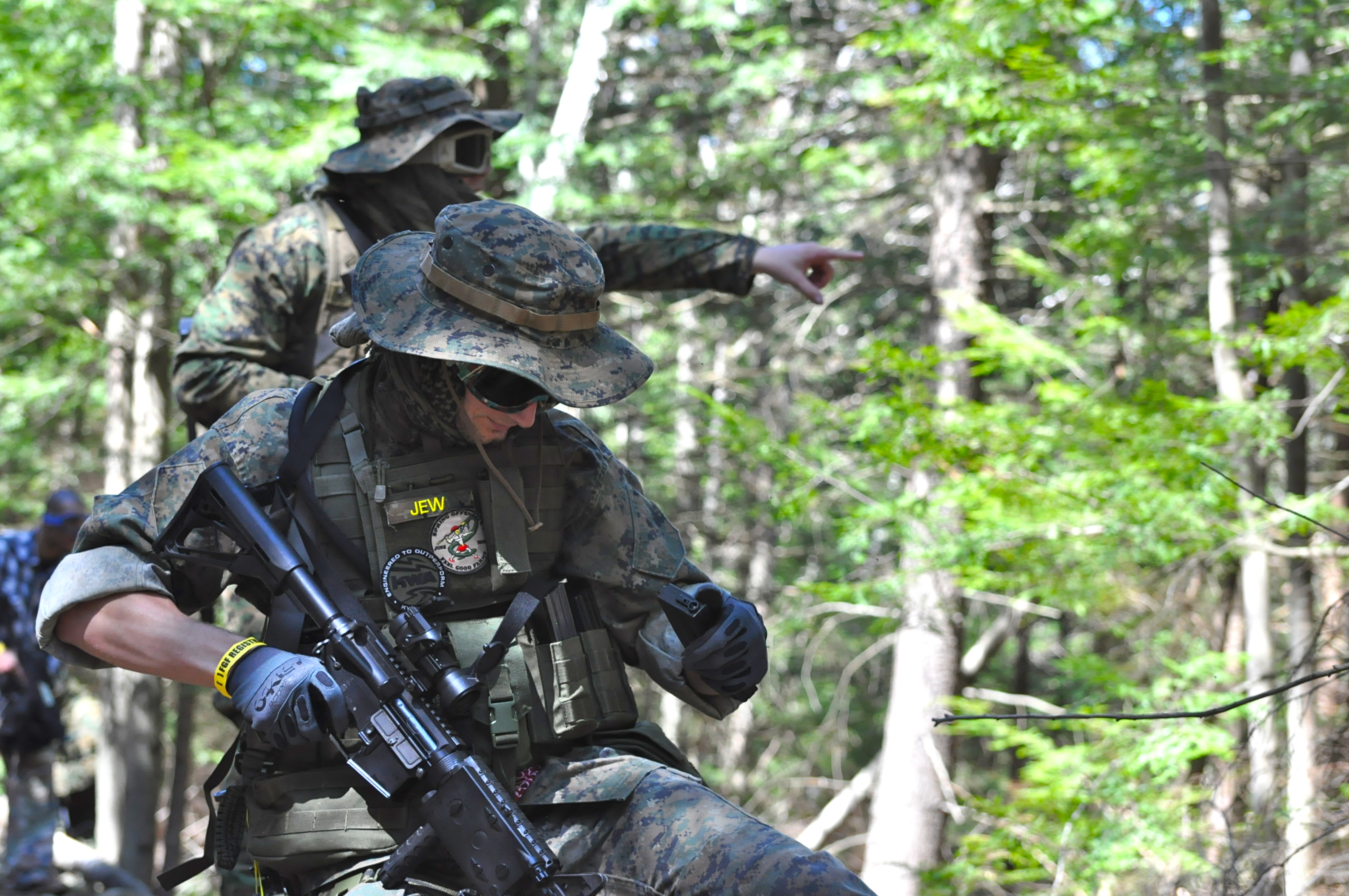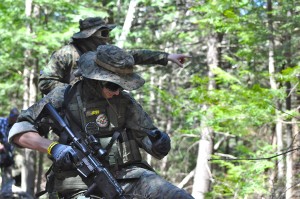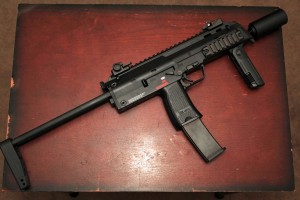Airsoft is a recreational activity in which participants launch spherical plastic projectiles at each other via spring, electric, or compressed-gas powered replica/toy firearms.
What makes Zach Billings an Airsoft authority?
History
Airsoft originated in Japan in the 1980s. It came out of the nationwide ban of all firearms. Airsoft guns were designed to very closely emulate real firearms and later evolved to become purely recreational in nature. They are now becoming increasingly popular, among military and law enforcement agencies, for use as training tools.
Safety
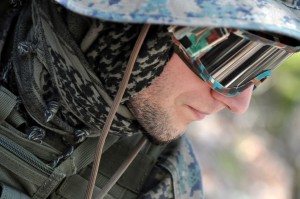
Safety in airsoft is a multifaceted system. The most common and well known piece of airsoft safety gear is ballistics goggles. Most insured fields, servicing airsofters, require all players to wear ballistics goggles that are ANSI Z87.1 rated. These goggles can withstand multiple hits by even the most powerful airsoft gun without taking damage that would compromise their safety. Airsoft fields also require players to chronograph their guns before they are permitted to fire at other players. The purpose of chronographing a projectile that is a known weight is to establish a maximum level of energy (measured in Joules) that an airsoft gun can produce at its muzzle. This ensures that no player is wielding a weapon that is producing more energy than the safety measures in place are able to cope with. The final piece of equipment-based safety is clothing. Most airsoft fields require that players below a certain age wear some form of face covering to protect their face and specifically their teeth from bb impacts.
The other side of airsoft safety which prevents players from accidentally shooting each other is standard firearm safety. This includes a range of standard practices that should be followed any time anyone is handling a projectile-firing device.
Four rules of firearm safety:
- All guns are always loaded.
- Never let the muzzle cover anything you are not willing to destroy.
- Keep your finger off the trigger until your sights are on the target.
- Be sure of your target and what is beyond it.
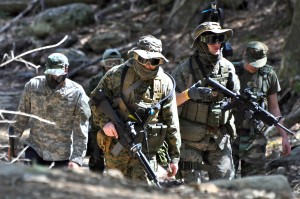
Much of the airsoft community is very close knit. Forums are the primary means by which airsofters can network, communicate, and share their knowledge. Airsoft Retreat is the largest national forum, which I personally recommend highly. It is a wealth of information, which can be navigated easily if you are familiar with forum use. In addition to national forums, hosting tens of thousands of members, there are also smaller regional forums. Living in New England, I personally use the New England Airsoft Group (NEASG). Where national forums are mostly used for talking about guns, gear, and the technical side of airsoft, local forums are used for coordinating events and teams, and many members within a local forum actually know each other on a face-to-face level. The airsoft community is generally a loyal and helpful one, where members look out for each other and are helpful.
In terms of demographic, airsofters range from 13-60 and span a range of income levels. The 13-18 year old range is quickly growing right now, but most current airsofters are in the 19-30 range. Around 2-5% of most airsoft events are female, with most females being in the 19-30 range.
Airsoft Combat
Airsoft is a combat sport in the same way that paintball is, however it is generally a little more diverse. Airsoft revolves around firing a projectile at an opponent in order to eliminate them from game-play in some fashion. Unlike paintball, where hits are clearly visible, airsoft bbs are non-marking. Due to this, airsoft is an honor sport in which players must acknowledge that they have been hit, even if no one else saw it happen.
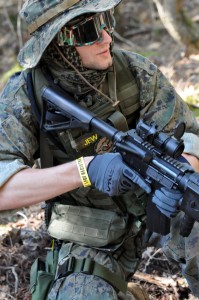
Getting a little more serious, some games may incorporate an objective into a force-on-force game. Variations on capture the flag are popular, and games are often played where one team starts in possession of an area and the other team must take it. In these cases there is a winner and a loser, but the nature of the scenario keeps opposing teams in close proximity to each other, inducing heavy combat. These types of games are usually popular with younger airsofters who are looking for a video game-like experience.
More serious still, and geared towards a more mature crowd, are MilSim (Military Simulation) games. These generally have elaborate back stories and complex objectives which may change on short notice throughout the day to add challenge. MilSim games generally involve an organized command structure on each team and are best played with total player-turnouts in the hundreds of people. MilSim games try to replicate the functionality of Military and are generally taken quite seriously.
The most serious level of airsoft would be the extreme version of MilSim. This is less common, as it requires inordinate amounts of money on both the field and the player’s parts. The gear, airsoft guns, and airsoft special weapons required for extreme MilSim may total $20,000 or more in order to be as effective as possible. At this level, fields must also have military-training quality facilities, as well as vehicles and even helicopters. A game of this type may cost over $200 for admission to 2-3 days of continuous play, in addition to the extreme expense of one’s actual gear.
Airsoft combat at the MilSim level is dull about 85% of the time and extremely intense the other 15. MilSim is centered around the completion of an objective, with shooting and combat being a side effect of the other team vying for the same objective. Within any team that is well established and experienced, one will often hear a great deal of command-yelling during an airsoft firefight. Communication and leadership are two skills that weigh very heavily into airsoft, especially at the MilSim level.
Legality
In the US, no state outlaws airsoft guns as a whole. Certain municipalities do have laws against airsoft guns, or require all airsoft guns to be either brightly colored or clear. In the vast majority of cities and towns, there are no laws against the replica firearms. There are, however, very strict laws against brandishing an airsoft gun in public, due to their highly realistic appearance. If one were to commit a crime using an airsoft gun as a prop, intended to be viewed as a real firearm, the legal system would charge that individual as if they had been using a real firearm without a license.
There is a great deal of confusion over what the law says about orange tips on airsoft guns. The law regarding this varies from state to state and town to town, but generally the law is similar to that of Massachusetts. Here, when you purchase the airsoft gun, it must have a blaze orange tip at the end of the gun that is no less than 6mm in length. Once you own the gun it is legal to remove the orange tip, but users should be cautioned that it does make it harder for law enforcement to know the gun isn’t real. There have been confirmed cases of law enforcement officers discharging their weapons at a suspect believed to be brandishing a firearm, when in fact it was an airsoft gun. At one point in Spring 2011, I had the police anonymously called to my house by someone who must have seen me in my yard with an airsoft gun that they thought was real. When the police arrived, I quickly unloaded all my guns and made sure the magazine wells of every gun were visible, so the officers would feel more at-ease. I invited them in to see every one of my guns so they could better understand what they were dealing with. Due to my responsible handling of the situation, they were not bothered by my ownership of an airsoft arsenal, however one officer picked up one of the better built guns in my arsenal, looked at me and said, “You know if I saw you walking down the street with this, you’d get shot in an instant.” Public display of an airsoft gun is not something to be taken lightly. In regards to orange tips, it is important that if you are traveling across state lines that you either temporarily replace your orange tip or wrap the muzzle in blaze orange tree-marking tape. You can’t possibly know the laws of every town you will pass through and need to make sure you take steps to operate within the law.
If, for some strange reason, one is to transport an airsoft gun on foot in public, it is important that the gun is contained in an inconspicuous gun bag. The bag should not appear to the layman to look like a gun bag. A lockable guitar bag is a safe bet. For vehicle transportation, every gun should be stored in a bag of some form that closes. All gun bags should be in the trunk of the vehicle out of plain view of the public. People have no way of knowing that your replica firearms aren’t real, and will call the police if they see them. You then only need a police officer in a bad mood to decide to confiscate your arsenal, which may have cost you thousands of dollars.
Airsoft Guns
Airsoft guns come in all shapes and sizes, and can span an enormous price range. More recently, airsoft guns have also started becoming quite technologically advanced and their engineering quality has risen sharply over the last 3-5 years. Some high-end airsoft manufacturers, such as KWA and Systema, have spent over $2million on R&D for a single airsoft gun. Both brands make the majority of their sales to the military and law enforcement markets for training purposes. Civilian sales are only secondary, however this leads to extremely high quality airsoft guns getting into the civilian market, as they have seeded down from law enforcement markets.
There are three primary types of airsoft gun. Spring powered guns, colloquially known as ‘Springers,’ compressed gas guns, and Automatic Electric Guns (AEGs) which use an electric motor to drive a spring powered piston.
Springers
Springers are the scum of the airsoft world, if we’re being honest. Springers are almost exclusively found at local sporting goods stores and are popular with younger kids with low budgets and no sense of safety. Springers can generally propel bbs at speeds up to 280fps with a .2g bb and must be charged, racked, or cocked before every shot. They are generally made almost completely of plastic and range in price from $20 to $50.
Gas Powered Guns
Gas powered airsoft guns have starting booming in the last year or two and are becoming very popular in the MilSim crowd and in demographics with more money to spend on the hobby. Gas guns used to play an exclusively secondary role to AEGs and were thought of as more of a status piece than a practical weapon.
Most gas guns operate as a Gas Blow Back (GBB) design. This impeccably emulates the functionality of real firearms and many people like GBB guns for their extreme realism. There also exists a very small number of Non Blow Back (NBB) gas guns, which use an internal mechanism to load each new bb. These are uncommon and unpopular. When the trigger of a GBB gun is pulled, a sequence begins that is very similar to a real firearm. The hammer or internal hammer falls, impacting a striker. This striker rams forward into a valve on the upper rear of the magazine, which contains a gas (usually Propane). This valve sends a jet of propane up into the expansion chamber inside the slide or bolt and some of that gas vents into the barrel, propelling the bb. As the gas vents into the barrel, it pushes against a sprung valve. Once the valve makes a seal with the barrel vent, the expansion chamber is sealed and the gas cannot escape (all the while, gas is blasting from the magazine). The expanding gas causes the expansion chamber to turn into a gas ram and it propels the bolt or slide rearward. When the bolt/slide returns it loads the next bb and resets the system. Slide/bolt action generally happens fast enough that you can only see a slight blur of motion. The entire cycle takes between .05 and .1 seconds on most airsoft guns.
Traditionally, GBB guns have been almost exclusively pistols, with only a couple off-brand sub-machine guns (SMGs). Since 2007, the number of GBBRs (Gas Blow Back Rifles) and GBB SMGs has been steadily increasing. The gas efficiency and useability of these weapons, including the pistols, has also risen sharply over the last few years, leading to some players fielding GBBRs as their primary weapon. When a particular brand (which makes gas guns of incredible quality) releases its upcoming M4A1 GBBR, I intend to switch to a gas-only load out. Presently, I use an AEG as my primary rifle but I use a GBB H&K MP7 (an SMG) as my sidearm/secondary weapon. Only a few years ago, mainstream GBB guns were relegated to use as a sidearm for emergencies only. You only pulled your pistol if your rifle actually failed and would not function. Now, GBB guns have become functional enough that I will regularly sling my rifle and switch to my airsoft MP7 when I know I will be entering an urban area.
GBB pistols usually range from $100 to $250. High end models often use components made of fiber polymers comparable to those used in real firearms and may use aircraft-grade aluminum or stainless steel for their metal components. GBB guns as a whole usually replicate the feel, weight, and even proper weight distribution of their ‘real steel’ counterparts to near perfection. I’ve had a police officer pick up some of my airsoft pistols and comment that he wouldn’t have known the difference without racking back the slide or disassembling the pistol. Most GBB pistols can propel a .2g bb at speeds as high as 380fps.
GBB SMGs demonstrate the same level of realism but range from $180-400 and can fire .2g bbs as fast as 450fps. GBBRs feature similar top end velocity. They generally feature recoil comparable to very small caliber real firearms (enough that automatic fire is difficult to control) and range in price from $300-1000, with most of the good ones around the $500 mark.
[Note about gas use for those concerned: Camping-style propane tanks are DOT approved for transportation because they are very safe. It is perfectly safe to store them indoors. Many people raise concerns about firing propane-powered GBB guns indoors because it vents propane into the air. This is not a concern. Propane is, relatively speaking, not an easy gas to ignite and it would require thousands of rounds of fire in a large or moderately ventilated room to reach flammable levels. I have emptied in excess of 2000 rounds indoors in a sitting with no problem. You will certainly get a strongly perceptible Propane smell for a while, but combustibility has been a non-issue.]Automatic Electric Guns (AEGs)
AEGs are the mainstay of the airsoft arsenal. They comprise around 95% of all primary weapons on a given airsoft field and you would be hard pressed to find an airsofter who has graduated from Springers that doesn’t own one.
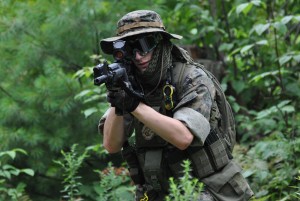
Due to their many electrical and mechanical components, AEGs are highly upgradeable. There is an enormous market for AEG upgrade parts, which is very similar in nature to the performance car parts market. AEGs are generally divided into LPEGs, MPEGs, and AEGs. Low Price Electric Guns, Mid Price Electric Guns, and Automatic Electric Guns. LPEGs may be as cheap as $75. They are usually very unreliable and are of low build quality. They are usually inaccurate, underpowered, and have an effective range less than 100ft. MPEGs generally run for $100-150 and are suitable for a first-time AEG buyer to learn the ropes. They will often last a little while if taken care of and can be accurate enough to actually use in combat. They are typically effective to 120ft or less.
AEGs span an enormous range in terms of both price and performance. Lower end AEGs can be as little as $150-250 and are usually marred by reliability issues more than anything. They are often of cheaper build quality, but maybe not unacceptably so. The mid-range of AEGs usually overlaps from $200-$350, however one extremely high end brand in particular overlaps the $300 price point. Mid-range AEGs are usually of good build quality and approach, if not reach realistic weight and feel. They are reliable if treated well, especially if any known reliability issues are dealt with, through modification, from the get-go. They are often good platforms for anyone who plans to heavily modify their AEG. Mid-range AEGs take up the largest portion of AEGs and often have an effective range of 175ft at the very best.
Higher end AEGs can range from $300-2000, making some of them more expensive than their real-steel counterparts. As previously mentioned, a large portion of this market segment is sourced from guns designed for law enforcement training, making them highly realistic and very functional out of the box. Effective range on an unmodified AEG can be as high as 200ft and modifications can be made to achieve 300ft or more of effective range. High end AEGs usually come with very high strength gearbox components and require very little reliability increase through modification, even if one wants to use a more powerful spring or motor. Velocities of AEGs can be increased to be as high as 650fps, with rare cases exceeding 700fps. A well-tuned high end AEG may have an effective range over 250ft, with a high rate of fire, and may perform without a single reliability issue for hundreds of thousands of rounds if regular maintenance is done.
AEGs can be used with real, mid, or high capacity magazines. Real cap magazines imitate the capacity of that firearm’s real steel magazine. Mid caps hold between 55 and 120 rounds in a spring tube within the mag. This keeps them feeding well and not rattling around, but allows for higher capacity than a real cap. High caps hold 200-600 rounds in a reservoir within the mag. A spring, that you hand wind at the beginning of the mag usage, feeds the bbs from the reservoir to the stack where they are pushed up to the gun. Most high caps can unload their entire capacity on a single wind of the spring. The drawbacks to high caps are that they rattle when you run because the bbs aren’t held in place and they are highly unrealistic. There are also motorized box magazines, used for support guns. These can hold up to 5000 rounds and feed using an electric motor.
Special Airsoft Weapons
For the most part, special airsoft weapons are niche items which are very uncommon. They often derive their firing system from other types of airsoft gun, namely gas guns. Under-barrel grenade launchers are relatively common. They use a gas shell, which is charged with Propane, to launch a shotgun-like spray of 80-200 bbs. Those seeking more realism simply buy a shell with a large gas charge and shove a 40mm NERF rocket in the launcher tube. When the launcher is fired, the NERF rocket flies out and hits the target. These are used in MilSim to “disable” vehicles. Many games also use a rule that states that if a NERF rocket lands within 15ft of you, you’re dead. Another special weapon is the rocket launcher. These may be modeled to look like LAW rocket launchers, RPGs, or AT4s. They use the same gas shells used in an under-barrel launcher and generally utilize 40mm NERF rockets as well. These are shoulder-fired.
Land mines and claymores are very uncommon, but are used. Land mines are loaded with a talcum powder charge. When stepped on, they use a gas charge to expel a cloud of powder, indicating a kill. Claymores use a trip cable or laser break-beam to signal the claymore to release a spring, which launches 200 bbs from the face of the claymore.
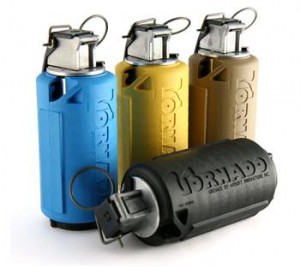
King of the special weapons world is the ECHO1 Minigun. It is modeled after the M134 minigun which, in real life, fires 60-70 rounds per second. The ECHO1 uses compressed air tanks to fire bbs through a 6-barrel cylinder, which is spooled by a 12V motorcycle battery. The unit weighs 36lbs, and can fire 65 bbs per second at 400fps. It costs $3,500, a small price to pay for the ultimate in zone denial and suppression. While many airsoft special weapons that are not main stream are poorly designed and faulty, the ECHO1 Minigun is an example of a highly functional, if somewhat impractical, special weapon.
Projectiles
Airsoft guns fire spherical projectiles called bbs (more appropriately, “BBs,” since BB stands for ‘Ball Bearing’). Airsoft bbs are considered to be 6mm in diameter, but really vary from 5.9 to 5.98mm to allow for clearance while traveling down the barrel. Airsoft bbs are generally made of some type of plastic or another, however one brand uses silica to make clear, highly consistent bbs. These are somewhat dangerous because they are effectively glass and can do more damage to safety goggles than most bbs. These are outlawed at many fields. [Note: I have done testing with silica bbs and concluded that high quality safety goggles, such as Flakjaks, will not fail even under prolonged automatic fire at close range. In one test I fired 100 rounds into a space the size of a nickel, from 5ft away. Afterward there was a deep indentation in the lens but the wearer would have remained protected. (Normal plastic bbs caused no indentation at all in an identical example of the same lens). The moral is that if you purchase proper safety goggles, no field-legal airsoft gun can possibly defeat them.]
Airsoft bbs range in weight by using different plastic densities and/or hollow pockets within the bb. Bb weight makes a tremendous difference in the flight characteristics and energy conservation of a bb, so choosing the correct weight for your gun and application is of paramount importance. The weight of a bb is measured in grams. The lightest bbs are 0.12g and are usually only found alongside Springers at sporting goods stores. .12s are not safe for use in medium to high end guns because at higher velocities they have a tendency to shatter in the barrel. Standard weights in use for airsoft are .20, .25, .28, .30, .36, and .43g bbs. Many off-brand bbs exist, filling the gaps between those numbers, but the major brands generally stick to the primary weights. .20s are common with newer players, however .25s are the lightest bb that should realistically be used. .25s and .28s are useful for medium to high power guns, with .30s and .36s used in high power guns, as well as snipers and designated marksman rifles (DMRs) (AEGs outfitted for a high effective range and used for sniping). .43g bbs are reserved pretty exclusively for snipers or very high powered AEGs.
Ballistics and Velocity
The standard for measuring the power of an airsoft gun, is to state its velocity when using a .20g bb. The reality is that this system is a measurement in Joules, however most players find it hard to familiarize themselves with a Joule system. Every airsoft field chronographs guns with a specific weight of bb to establish the muzzle energy of the gun. At Feel Good Farm, where I play, the standard measurement weight is .25s. The limit at the field is 400fps with .25g bbs. This translates to 1.8J of muzzle energy. Once a player has chonographed, they may use any weight bb they wish. As you use a heavier bb, your velocity will decrease proportionally. An airsoft gun that shoots at 1.8J with .25s will shoot at 1.8J with any and all bbs. The velocity will vary based on bb weight. [Note: Technically, a lighter bb from the same gun will actually carry slightly more energy, due to the way velocity effects energy, but for airsoft energy levels, it is safe to say that the relationship between bb weight/velocity is linear.]
It is a common misconception that a lighter bb will go faster and therefore equate to more range. A lighter bb will go faster at the muzzle, but will be affected by wind resistance and cross wind much more. A lighter bb will always stray farther, horizontally, than a heavy bb due to wind push. A lighter bb will also bleed energy much more quickly due to wind resistance. This means that even at 10ft from the muzzle, a .43 will strike with more energy than a .20. There is a magic distance, at which all standard weight bbs will have taken almost exactly the same time to reach their target, despite the fact that the lighter bbs started out faster. If you use a 2.8J gun (550fps with .2s) and fire one of every weight bb, at 162ft they all will have averaged about 245fps. Past 162ft, a heavier bb will have not only reached the target faster, but it will strike with multiple times the energy of the lighter bb. The only downside to using a heavier bb is if you’re shooting under 162ft. The bb will take a little longer to get there, but it will be much more stable in its flight. This means the .20 might get there faster than the .30, but the .20 might not hit the target due to wind drift.
Due to the rate at which airsoft bbs bleed energy, they slow down and drop off quickly (vertically). To counteract this, airsoft guns are equipped with what is called ‘hop-up.’ Airsoft guns have an adjustable system which causes a piece of rubber to intrude into the top of the barrel, at the very rear of the barrel. As the bb passes under this rubber, it picks up backspin. The backspin causes the bb to rise, counteracting gravity. A well broken-in hop-up, combined with a heavy bb can allow a bb to fly on a perfectly vertically straight path for over 150ft, before rising or falling. Without hop-up, a bb will strike the ground at around 90ft if fired parallel to the ground. Hop-up allows for both range and consistency, while only reducing bb velocity by 2-7%.
Locations and Fields
Airsoft is becoming increasingly popular nationwide, and is actually growing quite rapidly in the Northeast. Regional forums are the best way to figure out where one can find an insured airsoft field in their state or region. Across New England there are more than 20 insured fields, with a few hundred nationwide.
Fields range greatly is setup. Some are urban facilities with real buildings with multiple floors. Others are woodland or desert with urban facilities incorporated into them. Some are just woodland. Some are just desert. Field sizes can range from 5 acres to 500 acres and span all types of terrain. Some fields are former military training facilities and these are the types of locations likely to host extreme MilSim events. Larger fields may draw up to 200 players on a regular basis and turnouts in excess of 1000 players have been seen at national MilSim events. Fields will run games as short as a few hours or as long as a week of continuous, day and night play. Since airsoft is meant to emulate real-world combat, there is no where in the real world that the setting would not be accurate. Any location anywhere can be made into an airsoft field, regardless of size or layout. More extreme terrain may just require more extreme players.
Contact
For more information about the basics or specifics of airsoft as a sport/hobby, contact me by email. My email is my full name, with no spaces @gmail.com (written like this to avoid spam).
Team ACP’s pre-2011 season teaser video:

